All Kabuki DVDs have optional English commentary.
Where noted, certain titles also have English subtitles. |
| |
 |
|
|
Volume One
KANJINCHO: THE SUBSCRIPTION LIST
Featuring ICHIKAWA Danjuro XII, NAKAMURA Tomijuro V, ONOE Kikugoro VII
78 minutes, 1997
Kanjincho, a central piece in the Kabuki Repertoire, is one of the “Great 18 Plays” and dates back to 1840. Based on the Noh play, Ataka, Kanjincho recounts General Yoshitsune’s narrow escape from capture through the guileful intrigue of his loyal retainer Benkei.
|
|
|
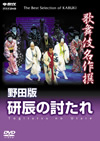 |
Volume Two
TOGITATSU NO UTARE: THE REVENGE ON TOGITATSU
Featuring NAKAMURA Kankuro V, BANDO Mitsugoro X, NAKAMURA Fukusuke IX
112 minutes, 2001
First staged in 1925, this is an updated version by noted contemporary director Noda Hideki. A comic drama, inspired by a real life event of 1827, this piece takes the age-old theme of samurai honor and revenge, presenting it in a refreshingly modern light with touches of irony.
|
| |
|
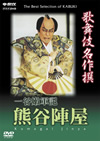 |
Volume Three
KUMAGAI JINYA: KUMAGAI’S BATTLE CAMP
Featuring MATSUMOTO Koshiro IX, NAKAMURA Jakuemon IV, ICHIKAWA Somegoro VII
86 minutes, 2002
One of the classics of the jidaimono or historical plays, this famous act chronicles a dramatic incident during the Battle of Ichinotani, during the long war between Genji and the Heike Clans.
General Kumagai is, like many Kabuki tragic heros, a victim of the medieval Japanese code of honor. Confronted with the prospect of having to kill the Emperor’s son, he beheads his own son instead. Released from further duty, he spends his last days as a wandering priest.
|
| |
|
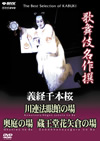 |
Volume Four
YOSHITSUNE SENBON ZAKURA: YOSHITSUNE & THE 1000 CHERRY TREES
(Three Scenes: Kawatsura Hôgen Yakata no Ba, Okuniwa no Ba, Zaôdôhanayagura no Ba)
Featuring ICHIKAWA Ennosuke III, BANDO Tamasburo V, ICHIKAWA Danshiro IV
99 minutes, 2000
The three scenes presented here are from the 4th and 5th act of Yoshitsune Senbon Zakura. Originally a Bunraku play, this is one of the most gorgeous and luxuriant works in the Kabuki repertoire. In the final scene, teamed with the great onnagata performer Tamasaburo, Ennosuke performs his signature piece as the enchanted fox. |
| |
|
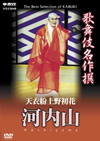 |
Volume Five
KOCHIYAMA: THE ROBBER KOCHIYAMA
Featuring NAKAMURA Kichiemon II, ICHIKAWA Sadanji IV
90 minutes, 1999
This play is a late masterpiece by KAWATAKE Mokuami, perhaps the last of the great traditional Kabuki playwrights. The main character, Kochiyama, is a notorious gambler and extortionist masquerading as a Buddhist Priest. NAKAMURA Kichiemon plays the lead role, which was also a specialty of his grandfather.
|
| |
|
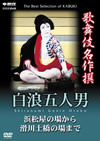 |
Volume Six
SHIRANAMI GONIN OTOKO: THE FIVE BANDITS
Featuring ONOE Kikugoro VII and ICHIKAWA Sadanji IV
102 minutes, 2000
The story of the notorious bandit Benten Kozô and his cohorts, a sinister and menacing group who live outside the law but who nevertheless abide by their own code of honour. ONOE Kikugoro, skillful at both male and female roles, plays both the samurai’s daughter and the villain Benten Kozô.
|
| |
|
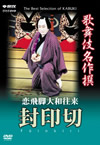 |
Volume Seven
FUINKIRI- BREAKING THE SEAL
Featuring NAKAMURA Ganjirô III, NAKAMURA Senjaku III, NAKAMURA Tomijûrô V
83 minutes, 1999
Fuinkiri is the central act of the great Chikamatsu drama, MEIDO NO HIKYAKU (THE COURIER FOR HELL). NAKAMURA Ganjirô plays the courier Chubei who, tormented by love for the courtesan Umegawa, cannot resist the temptation to break open a packet of money he is carrying for a customer. Once the seal is broken, all is lost and Chubei rushes to off to meet his lover.
|
 |
|
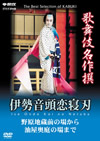 |
Volume Eight
ISE ONDO KOI NO NETABA: THE ISE DANCES & LOVE’S DULL BLADE
Featuring KATAOKA Nizaemon XV, NAKAMURA Jakuemon IV, BANDO Tamasaburo V
109 minutes, 1995
Based on an actual multiple murder in the Aburaya Tea House, this play is one of the most popular in the Kabuki repertoire, combining action, intrigue and a spectacularly grotesque murder. This play is a staple of summer Kabuki performances in the belief that the audience will be cooled as they shiver with fear through the horrific killing scene.
|
| |
|
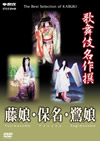 |
Volume Nine
FUJI MUSUME: THE WISTERIA MAIDEN Featuring ONOE Baiko VII (1987)
YASUNA Featuring NAKAMURA Shikan VII (2003)
SAGI MUSUME: THE HERON MAIDEN Featuring BANDO Tamasaburo V (2002)
73 minutes
The three great dances of Kabuki performed by some of the greatest onnagata performers.
FUJI MUSUME is a dance of unrequited love; the Wisteria Maiden recalls the promises of an unfaithful lover. YASUNA is a court astrologer who goes mad with grief after his betrothed
commits suicide when caught up in a court intrigue. SAGI MUSUME, is also a story of unrequited love. The heron is transformed as a maiden who remembers her tragically unfulfilled longings through dance.
|
| |
|
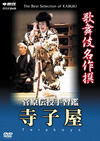 |
Volume Ten
TERAKOYA: THE VILLAGE SCHOOL
Featuring MATSUMOTO Koshiro VIII, NAKAMURA Ganjirô II, NAKAMURA Shikan VII
89 minutes, 1975
The final act of Sugawara's Secrets of Calligraphy presents one of the great tragic moments in all Kabuki. Matsuomaru and his wife Chiyo sacrifice their own child so that the son of their Lord Michizane may live.
|
| |
|
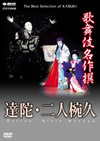 |
Volume Eleven
DATTAN – THE FIRE RITUAL
Featuring NAKAMURA Shoroku II
42 minutes, 1970
First performed in 1967, this dance piece is a recreation of the annual Shuni-e ritual that takes place at the great Todaiji Temple in Nara. This ritual was performed to prevent natural disasters, epidemics and rebellions and to ensure bountiful harvests and peace across the Nation.
NININ WANKYU – THE TWO WANKYUS
Featuring NAKAMURA Shoroku II, NAKAMURA Tomijuro V, NAKAMURA Jakuemon IV
37 minutes, 2000
One of the oldest dances in the Kabuki repertoire, Ninin Wankyû recounts the story of Wanya Kyûbei, the son of a rich merchant who fell in love with the courtesan Matsuyama. He squanders such huge amounts of money on his visits to the courtesan that his parents finally place him under house arrest. Kyûbei escapes and wanders the streets penniless, eventually drowning in the Aji River.
|
| |
|
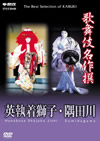 |
Volume Twelve
SUMIDAGAWA: SUMIDA RIVER
Featuring NAKAMURA Utaemon VI, NAKAMURA Kanzaburo XVII
46 minutes, 1986
A widow discovers that her only son has gone missing from his temple school. While searching for her lost child, she encounters a boatman on the Sumida River who leads her to his grave. Learning of her son's death, the woman madly chases after his ghost, then collapses on his grave, vowing to spend the rest of her life in prayer.
HANABUSA SHUJAKU JISHI: SHUJAKU LION DANCE
Featuring NAKAMURA Jakuemon IV
31 minutes, 2001
A dance piece derived from the Noh play Shakkyo, Shûjaku Jishi shows a courtesan performing a classic lion dance. The lion invades her spirit and she starts to dance in a frenzy to free herself. Like all lion dances in Kabuki, this piece is a great test of the dancing skills of the onnagata (female role player) performer.
|
| |
|
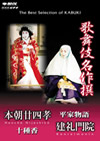 |
Volume Thirteen
JUSSHUKO: TEN TYPES OF INCENSE
Featuring NAKAMURA Utaemon VI, ONOE Baiko VII, NAKAMURA Shikan VII, KATAOKA Nizaemon XIII
57 minutes, 1983
This piece is one of the great examples of Kabuki plays adapted from the Bunraku Puppet Theatre. The role of Princess Yaêgaki, here played by Utaemon, is one of the most difficult princess roles in the repertoire. Set in the 16th century, Jusshuko depicts a power struggle between two warlords feuding over a sacred helmet.
KENREIMONIN
Featuring NAKAMURA Utaemon VI, SHIMADA Shogo
57 minutes, 1995
Drawn from The Tale of the Heike, this plays recounts the dramatic and tragic life of Taira no Tokuko who took the name of Kenreimonin. In this act, Kenreimonin renounces the world in order to become a Buddhist nun. She spends the remainder of her life praying for the souls of her dead Heike clansmen. |
| |
|
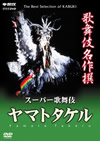 |
Volume Fourteen
YAMATO TAKERU; SUPER KABUKI
Featuring ICHIKAWA Ennosuke III, ICHIKAWA Danshiro IV, ICHIKAWA Emiya II
180 minutes, 1995
Yamato Takeru is the legend of the second century warrior hero who conquered the southern islands, expanding the territory of Japan for the Imperial Government.
During the 1990's Ichikawa Ennosuke III, one of the Kabuki world's biggest stars, mounted a series of modernized Kabuki works calling them Super Kabuki. Yamato Takeru was the first and most famous.
|
| |
|
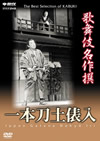 |
Volume Fifteen
IPPON GATANA DOHYO IRI: THE WRESTLING RING AND THE SWORD
Featuring NAKAMURA Utaemon VI, NAKAMURA Kanzaburo XVII
94 minutes, 1983
A play from the 1930's featuring characters from the underworld; gangsters, petty thieves and prostitutes. The wrestler Mobei, finding himself penniless, is helped by the waitress Otsuta. Years later he re-visits her tea house and is able to repay her kindness. |
| |
|
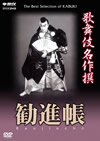 |
Volume Sixteen
KANJINCHO: THE SUBSCRIPTION LIST
Featuring ONOE Kikugoro VI, MATSUMOTO Koshiro VII, ICHIMURA Uzaemon XV
77 minutes, 1943, Black & White
This early film version of Kanjincho features many of the legendary Kabuki performers of the mid-twentieth century, especially Kikugoro VI, considered one of the greatest actors in Kabuki history.
Kanjincho, a signature piece in the Kabuki Repertoire, is one of the "Great 18 Plays" and dates back to 1840. Based on the Noh play, Ataka, Kanjincho recounts General Yoshitsune's narrow escape from assassination with the help of his loyal retainer Benkei.
|
|
|
 |
This four volume set (5 DVDs) covers the most important scenes of one of the greatest works in all Japanese theater. Based on a true story of revenge more widely known as the "Tale of the 47 Ronin", this story has been adapted in countless films, including Kenji Mizoguchi's, Genroku Chushingura, 1941.
|
|
Volume
Seventeen
KANADEHON CHUSHINGURA Part 1
of 4
Featuring ONOE Shoroku II, ONOE Baiko
VII, ICHIMURA Uzaemon XVII and NAKAMURA Shikan
190 minutes, 1977, with English subtitles
Prologue
Act 3 At the Gate of the Ashikaga Mansion and Bloodshed in the Pine Room
Act 4 Hangan's Harakiri, and Surrendering the Mansion |
|
|
 |
|
|
Volume
Eighteen
KANADEHON CHUSHINGURA Part 2
of 4
Featuring NAKAMURA Kanzaburo XVII, ONOE
Baiko VII, NAKAMURA Utaemon VI and ICHIMURA Uzaemon XVII
154 minutes, 1977, with English subtitles
Michiyuki Scene of Okaru and Kampei
Act 5 The Yamazaki Highway & The Two Bullets
Act 6 The Suicide of Kanpei |
|
|
 |
|
|
Volume
Nineteen
KANADEHON CHUSHINGURA Part 3
of 4
Featuring ONOE Shoroku II, NAKAMURA
Utaemon VI and MATSUMOTO Koshiro VIII
106 minutes, 1977, with English subtitles
Act 7 The Ichiriki Teahouse in Gion,
Kyoto |
|
|
 |
|
|
Volume
Twenty
KANADEHON CHUSHINGURA Part 4
of 4
Featuring NAKAMURA Utaemon VI, MATSUMOTO
Koshiro VIII, KATAOKA Nizaemon XIII, NAKAMURA Shikan, NAKAMURA
Jakuemon and ONOE Shoroku II
123 minutes, 1977, with English subtitles
Act 9 Seclusion in Yamashina
Act 11 The Attack on Morono's Mansion |
|
|
 |
|
|
Volume
Twenty One
SUKEROKU: FLOWER OF EDO
Featuring ICHIKAWA Danjuro XII, ONOE
Kikugoro V, ICHIKAWA Sadanji, NAKAMURA Jakuemon
119 minutes, 2003, with English subtitles
One of the great entertainments of Kabuki, Sukeroku tells the story of the handsome and dashing Sukeroku and his lover, Agemaki. One of The Eighteen Favorite Plays (Juhachiban) of the Ichikawa family of actors. First performed in 1713. |
|
|
 |
|
|
Volume
Twenty Two
KUROZUKA: THE BLACK MOUND
Featuring ICHIKAWA Ennosuke III, SAWAMURA
Sojuro IX, ICHIKAWA Danshiro, and ICHIKAWA Monnosuke.
78 minutes, 1995
A dance work based on the Noh play Adachigahara shows Ennosuke at his best playing the part of the old woman Iwate, a demon in disguise. First performed in 1939 by Ennosuke's grandfather Eno. |
|
|
 |
|
|
Volume
Twenty Three
AKOYA - THE COURTESAN AKOYA
Featuring BANDO Tamasaburo V, NAKAMURA Kankuro V (renamed Kanzaburo XVIII), NAKAMURA
Baigyoku IV
76 minutes, 2002, with English subtitles
The famous love story of Akoya and Kagekiyo, a warrior of the Heike Clan. Akoya is captured and threatened with torture if she does not reveal the whereabouts of her lover. In a highly emotional musical scene, Akoya manages to persuade her captors that she does not know her lover's whereabouts. |
| |
|
|
|
 |
|
|
Volume
Twenty Four
THE RENOWNED BANZUI CHOBEI
Featuring MATSUMOTO Koshiro IX, ONOE Kikugoro VII, NAKAMURA Shikan VII, NAKAMURA Kankuro V, ICHIKAWA Sadanji IV.
92 minutes, 1988
Banzui Chobei is a "sewamomo" or domestic drama, first performed in 1881. The chief character, Chobei, is a former samurai trying to adapt to changes in society at the close of the Edo Period.
|
| |
|
|
|
 |
|
|
Volume
Twenty Five
GOSHO NO GOROZO: THE GALLANT
GOROZO
Featuring ONOE Kikugoro, NAKAMURA Shikan VII, ICHIKAWA Sadanji IV
BANDO Mitsugoro X
73 minutes, 2001
The story of an "otokodate", a Robin Hood type of character said to have been common after the end of the samurai era, tells the story of the conflict between two former samurai, Gorozo and his enemy Hoshikage Doemon. |
| |
|
|
|
 |
|
|
Volume
Twenty Six
KENUKI: THE WHISKER TWEEZERS and NARUKAMI THE PRIEST
Featuring: ICHIKAWA Danjuro XII, NAKAMURA Tokizo V, ICHIKAWA Ebizo IX
ONOE Baiko VII
Kenuki, 2005
Narukami, 1956, black & white
157 minutes, with English subtitles
This DVD presents two of the greatest plays from Kabuki's "18 Favorite Plays" - the "Kabuki juhachiban". Kenuki and Narukami are representative works of the Ichikawa Danjuro line of actors and display their famed aragoto bravura-acting style.
|
| |
|
|
|
 |
|
|
Volume
Twenty Seven
Featuring ONOE Shoroku II, ONOE Baiko VII
104 minutes, 1934 (Sakanaya Sogoro), 1982 (Ibaraki)
Sakanaya Sogoro - Sogoro the Fishmonger - was originally adapted from a Bunraku puppet play featuring an hilarious sequence in which Sogoro drinks himself into a stupor.
Ibaraki is a dance piece based on the legend of Ibaraki Doji a demon who resided at Rashomon Gate at Toji Temple in Kyoto. |
| |
|
|
|
 |
|
|
Volume
Twenty Eight
IGAGOE DOCHU SUGUROKU - IN
NUMAZU
Featuring NAKAMURA Ganjiro II and KATAOKA Nizaemon XIV
109 minutes, 1980
The story of divided loyalties and a long-standing vendetta over a murder. In the Numazu acts, presented here, a son and father find themselves on the opposite sides of a conflict. Each remaining loyal to his own cause, they are prevented from revealing their true identities. |
| |
|
|
|
 |
|
|
Volume
Twenty Nine
DATE NO JUYAKU: TEN ROLES OF
THE DATE CLAN
Featuring ICHIKAWA Ennosuke III, ICHIKAWA Danshiro
177 minutes, 1986
In this spectacular play, revived in 1979, Ichikawa Ennosuke plays 10 roles, both female and male, through 47 quick costume changes on-stage and off. In the grand finale, playing the fierce hero, Nikki Danjo, Ennosuke flies over the heads of the audience at the Kabuki-za Theatre in Tokyo. |
| |
|
|
|
 |
|
|
Volume
Thirty
YOSHITSUNE SENBON ZAKURA: TOKAI-YA,
DAIMOTSU NO URA
Featuring KATAOKA Nizaemon, NAKAMURA Fukusuke, NAKAMURA Shikan VII
108 minutes, 2004
This DVD presents the scenes Tokai-ya and Daimotsu no Ura; from the second act of Yoshitsune Senbon Zakura, originally one of the great masterpieces of the Bunraku Puppet Theatre. The scene ends with a powerful sequence in which warrior Tomomori, tied to huge anchor, throws himself into the sea. |
| |
|
|
|
 |
|
|
Volume
Thirty One
ISHIKIRI KAJIWARA - STONE CUTTING
KAJIWARA
Featuring NAKAMURA Kichiemon II, NAKAMURA Tomijuro V
85 minutes, 1999
The story of legendary swordsman Kajiwara Heizo and a treasured sword belonging to the Genji clan. Kajiwara demonstrates the power of the sword by splitting a stone water trough in two. |
|
|
 |
|
|
Volume
Thirty Two
THREE KABUKI DANCES
BO SHIBARI, Featuring NAKAMURA Kankuro V
, BANDO Yajuro, BANDO Mitsugoro X TOSHIMA, Featuring
NAKAMURA Shikan VII
TOMO YAKKO, Featuring NAKAMURA Tomijuro V
76 minutes, 2004 and 1984
Bo Shibari is an hilarious dance piece in which the key characters manage to become progressively drunk even as they are tied to a pole.
In Toshima a former geisha dances amongst the falling cherry blossoms as she recalls the days of her youth in the pleasure quarters.
In Tomo Yakko, a servant comically imitates the mannerisms of his absent master. |
| |
|
|
|
 |
|
|
Volume
Thirty Three
KINKAKUJI: THE TEMPLE OF THE
GOLDEN PAVILION
Featuring NAKAMURA Jakuemon IV, MATSUMOTO Koshiro, NAKAMURA Shikan VII
96 minutes, 2003
Set in gorgeous Kinkakuji, The Temple of the Golden Pavilion in Kyoto, this play is about an encounter between the warrior Matsunaga Daizen and the Princess Yuki. This scene features particularly elaborate staging unique to Kabuki. |
| |
|
|
|
 |
|
|
Volume
Thirty Four
KAMIYUI SHINZA (TSUYU KOSODE MUKASHI HACHIJO): SHINZA THE BARBER
Featuring NAKAMURA Kankuro V (later NAKAMURA KANZABURO XVIII), NAKAMURA Shikan VII, BANDO Tamasaburo V, NAKAMURA Tomijuro V
136 minutes, + 23 minute extra feature, 2001, colour
Written by KAWATAKE Mokuami, and first performed in 1873. The story is based on an incident from 1727 when the daughter of a lumber merchant killed her betrothed and was found guilty of murder. This DVD features many of the most popular contemporary Kabuki actors.
|
|
|
 |
|
|
Volume
Thirty Five
Kyokanoko Musume Ninin Dojoji: THE TWO MAIDENS AT DOJOJI
Featuring: BANDO Tamasburo V, and ONOE Kikunosuke V
68 minutes, plus 23 minute extra feature, 2009, colour
This spectacular dance piece is considered the greatest challenge for onnagata performers, requiring great stamina, depth of expression
and consummate technique. The original story of Dojoji Temple is a very old Buddhist cautionary tale warning against a woman's frightening
attachment in love. |
|
|
 |
|
|
Volume
Thirty Six
Toryu Oguri Hangan: OGURI HANGAN
Featuring ICHIKAWA ENNOSUKE; JITSUKAWA Enjaku III; SAWAMURA Sōjūrō IX; ICHIKAWA Danshirō IV, ICHIKAWA Monnosuke VII
178 minutes, plus 23 minute extra feature, colour, 1983
This play follows the exploits of the famous warrior Oguri Hangan, who was renowned for his horsemanship. This DVD is a compilation of the highlights and principal acts of this toshi kyogen (full length play) revived by Ennosuke who is known for his spectacular staging. |
|
|
 |
|
|
Volume
Thirty Seven
99 minutes, + 23 minute special feature, colour, 2003 and 2006
SHIBARAKU: Wait a Moment!
Featuring: ICHIKAWA Danjūrō XII, BANDO Mitsugoro X
One of the KABUKI EIGHTEEN BEST PLAYS (Kabuki Juhachiban) associated with the Ichikawa Danjuro line of actors, Shibaraku is one of the finest examples of aragoto or "wild" acting style by Danjuro to portray superheroes or villains.
UIRO URI: The Medicine Peddler
Featuring: ICHIKAWA Danjūrō XII, ONOE Kikugoro VII
Also among the Eighteen Best Plays, this work was originally created in 1718 by Danjuro II. The highlight of this play is the speech of a street pedlar whose fast sales talk advertises a special Chinese medicine called Uiro.
|
|
|
 |
|
|
Volume
Thirty Eight
TSUMORU KOI YUKI NO SEKI NO TO: The Snowbound Barrier
Featuring: MATSUMORO Kōshirō VIII, NAKAMURA Utaemon VI; ONOE Baikō VII
Written by Takarada Jurai (lyrics), Tobaya Rich» I (music) and Nishikawa Senz» II (choreography) and first performed in 1784.
90 minutes, plus 23 minute special feature, colour, 1979
A masterpiece of the Tokiwazu style of musical performance this dance drama is a perennial favorite of the Kabuki stage. This performance includes
three of the greatest of all Kabuki actors.
|
|
|
 |
|
|
Volume
Thirty Nine
YOWA NASAKE UKINA NO YOKOGUSHI: SCARFACE YOSABURO
Featuring: ICHIKAWA Danjūrō XI, NAKAMURA Utaemon VI, NAKAMURA Kanzaburō XVII, ICHIKAWA Ennosuke II
Written by Segawa Joko III and first staged in 1853
75 minutes, plus 23 minute extra feature, black and white, 1963
This work is a pure kizewa domestic play, which features more realistically the lives of ordinary townspeople, including denizens of the lowest stratum of society, beggars, petty thieves and extortionists. Many of Kabuki's most important post-war actors perform. |
|
|
 |
|
|
Volume
Forty
MEIBOKU SENDAI HAGI
Featuring one of the greatest Kabuki onnagata of all time, NAKAMURA Utaemon along with ONOE Shoroku II, NAKAMURA Kanzaburo XVII and JITSUKAWA Enjaku.
Written by NAGAWA Kamesuke and first staged in Osaka in 1777 this jidai-mono, or historical play, follows the succession dispute in the Date Clan of Sendai.
115 minutes, 1983, colour
Utaemon provides a bravura performance as Masaoka, nurse of the Daimyo's son |
|
|
 |
|
|
Volume
Forty One
MEKURA NAGAYA UME GA KAGATOBI: Kagotobi
Featuring: ONOE Saharaku II, ICHIKAWA Uzaemon, NAKAMURA Kichiemon, NAKAMURA Jakuemon
Written in 1886, Kagotobi was first performed in 1886
89 minutes, 1981, colour
This play has two parallel stories. One concerns the misdemeanours of a supposedly
blind masseur and the other tells of the rivalry between two groups of fire-fighters.
|
|
|
 |
|
|
Volume
Forty Two
ONNA GOROSHI ABURA NO JIGOKU: The Woman Killer and the Hell of Oil
Featuring: KATAOKA Nizaemon XV, NAKAMURA Karoku V, NAKAMURA Baigyoku IV
110 minutes, 2009, colour
One of the most gruesome of the sewamono, domestic tragedies, by playwright CHIKAMATSU Monzaemon. First performed in 1721 at the Takemoto puppet theatre in Osaka, it is reputedly based on a real murder that occurred earlier the same year. |
|
|
 |
|
|
Volume
Forty Three
ICHIJO OKURA MONOGATARI: The Tale of Ichijo
Featuring: NAKAMURA Kanzaburo XVII, NAKAMURA Utaemon VI, KATAOKA Nizaemon XIII, NAKAMURA Shikan VIII
83 minutes, 1978, colour
This play by BUNKODO and HASEGAWA Senshi dates back to 1731 when it was first performed in the puppet theatre. Set in the 12th century, after a failed attempt on the life of Kiyomori, leader of the Genji clan. |
|
|
 |
|
|
Volume
Forty Four
MORITSUNA JINYA: Moritsuna's Battle Camp
Featuring: NAKAMURA Kichiemon II, BANDO Tamasaburo V, ICHIKAWA Sadanji IV, ONOE Shoroku IV
119 minutes, 16:9, 2008, colour
One of the great classics of the Kabuki repertoire, Moritsuna's Battle Camp is a jidaimono (historical play) first performed as Act VIII of the long work, Omi Genji Senjin Yakata. This work was written by a group of playwrights led by CHIKAMATSU Hanji and concerns the aftermath of the Seige of Osaka of 1614~15 |
|
|
 |
|
|
Volume
Forty Five
YAKKO DOJOJI: The Foot Man at Dojoji
Featuring: BANDO Mitsugoro X
85 minutes, 2001, colour
The Foot Man at Dojoji is a humorous dance number parodying the famous Kyokanako Musume Dojoji about a passionate girl who falls in love with a priest then takes revenge when she is jilted. A woman appears at the temple to dance for the dedication of the new bell, but soon she is revealed to be a male comic actor in disguise. Using three different masks which he changes in fast succession, the dancer tells the story of love between a man and woman.
KISEN: Kisen The Priest
Featuring: NAKAMURA Tokizo
23 minute, 2008, colour
The dance Kisen features the 9th century poet priest, Kisen Hoshi. It belongs to the category of transformation pieces, or hegemono, which feature a single actor dancing a series of contrasting roles in quick succession.
|
|
|
 |
|
|
Volume
Forty Six
KAWASHO: The Kawasho Teahouse
Performed by Living National Treasure, NAKAMURA GANJIRO, who has since taken the illustrious Kabuki name, SAKATA Tojuro IV.
100 minutes, 1997
Featured on this DVD is one act of the play Shinju Kamiya Jihei, The Love Suicide of Kamiya Jihei which was adapted by CHIKAMATSU Hanji from one of the most famous of all
works of Japanese literature, Shinju Ten no Amijima, The Love Suicides at Amijima.
|
|
|
 |
|
|
Volume
Forty Seven
THREE KABUKI DANCES: Vol 2
Bungo Dojoji: The Bungo Style Dojoji
featuring NAKAMURA Jakuemon IV
Ukare Bozu: The Merry Priest
featuring NAKAMURA Tomijuro V
Onna Date: The Female Dandy
featuring NAKAMURA Shikan VII
61 minutes, colour, various years
The three unrelated dances on this DVD are performed by some of the greatest Kabuki performers in recent memory, all designated Living National Treasures in their time.
Jakuemon, Tomijuro and Shikan are all seen here at the height of their artistic powers.
"Bungo Dojoji" is a variation on the classic Dojoji story, "Ukare Bozu; The Merry Priest" features a street beggar posing as a priest to collect money for his own purposes, and "Onna Date: The Female Dandy" tells the story of a courtesan who dozes off and dreams of herself as different characters.
|
|
|
 |
|
|
Volume
Forty Eight
SUGAWARA DENJU TENARAI KAGAMI: Sugawara's Secrets of Calligraphy /GA NO IWAI: The Birthday Celebration
Featuring: ICHIKAWA Danjuro XII, NAKAMURA Baigyoku IV, and NAKAMURA Kichiemon II
104 minutes, colour, 2002
First performed on 1746, Sugawara's Secrets of Calligraphy was written for the puppet theatre and adapted soon after for Kabuki. It tells the story of Sugawara no Michizane, famed master of calligraphy. Two acts from the full length drama are included in this DVD, "Kuruma Biki - Pulling the Carriage Apart", and "Ga no Iwai: The Birthday Celebration".
|
|
|
 |
|
|
Volume
Forty Nine
JINMON & KUMIUCHI: At the Gate of the War Camp & Grappling on the Shore
Featuring: MATSUMOTO Koshiro IX and NAKAMURA Fukusuke IXI
75 minutes, colour, 2006
The scenes on this DVD come from Act II of the five-act history play, Ichinotani Futaba Gunki, The Chronicles of the Battle of Ichinotani. First performed
in the puppet theatre in 1751, it was adapted for Kabuki the following year and has since become one of Kabuki's most famous classics. Kumagai Jinya (Volume Three)
is another famous Act from The Chronicles of the Battle of Ichinotani.
|
|
|
 |
|
|
Volume
Fifty
YUKINO YUUBE IRIYA NO AZEMICHI: The Love of Michitose & Naozomurai
Featuring: NAKAMURA Tokizo, ONOE Kikugoro, SAWAMURA Tanosuke, ONOE Matsusuke
67 minutes, colour, 2004
Written by KAWATAKE Mokuami and first performed in 1881, this DVD contains the second part of a longer play.
Volume Five of this series, Kochiyama, is an earlier Act from this work. The Love of Michitose and Naozimurai is noted for its beautiful kiyomoto musical accompaniment and a moving lamentation scene that is performed in dance mime.
|
|
|
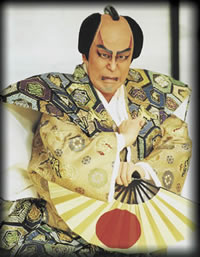
For More Information
Contact Marty Gross Film Productions, Inc. 416.536.3355 or
email videos@martygrossfilms.com for
more information about purchasing or licensing these films for broadcast.
|
